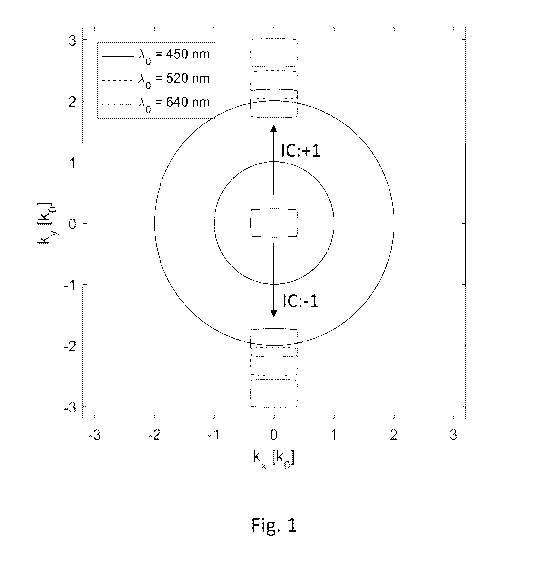Some of the information on this Web page has been provided by external sources. The Government of Canada is not responsible for the accuracy, reliability or currency of the information supplied by external sources. Users wishing to rely upon this information should consult directly with the source of the information. Content provided by external sources is not subject to official languages, privacy and accessibility requirements.
Any discrepancies in the text and image of the Claims and Abstract are due to differing posting times. Text of the Claims and Abstract are posted:
| (12) Patent Application: | (11) CA 3087609 |
|---|---|
| (54) English Title: | WAVEGUIDE ELEMENT AND WAVEGUIDE STACK FOR DISPLAY APPLICATIONS |
| (54) French Title: | ELEMENT DE GUIDE D'ONDES ET EMPILEMENT DE GUIDES D'ONDES POUR APPLICATIONS D'AFFICHAGE |
| Status: | Application Compliant |
| (51) International Patent Classification (IPC): |
|
|---|---|
| (72) Inventors : |
|
| (73) Owners : |
|
| (71) Applicants : |
|
| (74) Agent: | ROBIC AGENCE PI S.E.C./ROBIC IP AGENCY LP |
| (74) Associate agent: | |
| (45) Issued: | |
| (86) PCT Filing Date: | 2019-03-08 |
| (87) Open to Public Inspection: | 2019-10-03 |
| Availability of licence: | N/A |
| Dedicated to the Public: | N/A |
| (25) Language of filing: | English |
| Patent Cooperation Treaty (PCT): | Yes |
|---|---|
| (86) PCT Filing Number: | PCT/FI2019/050188 |
| (87) International Publication Number: | WO 2019185977 |
| (85) National Entry: | 2020-07-03 |
| (30) Application Priority Data: | ||||||
|---|---|---|---|---|---|---|
|
The invention relates to a waveguide display element comprising a waveguide body and an in-coupling grating (21) arranged to the waveguide body. The in-coupling grating (21) is configured to couple incoming light into the waveguide body into two separate directions (26A, 26B) using opposite diffraction orders (IC:+1, IC:-1) for splitting the field of view of the incoming light. Further the in-coupling grating (21) is configured, typically by setting its period suitably short, such that said coupling takes place only at wavelengths below a threshold wavelength residing in the visible wavelength range. The invention also relates to a waveguide stack (51 A, 51 B, 51 C).
L'invention concerne un élément d'affichage à guide d'ondes comprenant un corps de guide d'ondes et un réseau d'injection par couplage (21) disposé sur le corps de guide d'ondes. Le réseau d'injection par couplage (21) est configuré pour coupler la lumière entrante dans le corps de guide d'ondes dans deux directions séparées (26A, 26B) en utilisant des ordres de diffraction opposés (IC:+1, IC:-1) afin de diviser le champ de vision de la lumière entrante. En outre, le réseau d'injection par couplage (21) est configuré, habituellement en réglant sa période suffisamment courte, de telle sorte que ledit couplage a lieu uniquement à des longueurs d'onde inférieures à une longueur d'onde de seuil résidant dans la plage de longueurs d'onde visibles. L'invention concerne également un empilement de guides d'ondes (51 A, 51 B, 51 C).
Note: Claims are shown in the official language in which they were submitted.
Note: Descriptions are shown in the official language in which they were submitted.

2024-08-01:As part of the Next Generation Patents (NGP) transition, the Canadian Patents Database (CPD) now contains a more detailed Event History, which replicates the Event Log of our new back-office solution.
Please note that "Inactive:" events refers to events no longer in use in our new back-office solution.
For a clearer understanding of the status of the application/patent presented on this page, the site Disclaimer , as well as the definitions for Patent , Event History , Maintenance Fee and Payment History should be consulted.
| Description | Date |
|---|---|
| Compliance Requirements Determined Met | 2024-04-20 |
| Letter Sent | 2024-03-08 |
| Letter Sent | 2024-03-08 |
| Common Representative Appointed | 2020-11-07 |
| Inactive: Cover page published | 2020-09-08 |
| Letter sent | 2020-07-24 |
| Inactive: IPC assigned | 2020-07-23 |
| Inactive: IPC assigned | 2020-07-23 |
| Request for Priority Received | 2020-07-23 |
| Priority Claim Requirements Determined Compliant | 2020-07-23 |
| Inactive: IPC assigned | 2020-07-23 |
| Application Received - PCT | 2020-07-23 |
| Inactive: First IPC assigned | 2020-07-23 |
| Inactive: IPC assigned | 2020-07-23 |
| Inactive: IPC assigned | 2020-07-23 |
| Inactive: IPC assigned | 2020-07-23 |
| National Entry Requirements Determined Compliant | 2020-07-03 |
| Application Published (Open to Public Inspection) | 2019-10-03 |
There is no abandonment history.
The last payment was received on
Note : If the full payment has not been received on or before the date indicated, a further fee may be required which may be one of the following
Please refer to the CIPO Patent Fees web page to see all current fee amounts.
| Fee Type | Anniversary Year | Due Date | Paid Date |
|---|---|---|---|
| Basic national fee - standard | 2020-07-03 | 2020-07-03 | |
| MF (application, 2nd anniv.) - standard | 02 | 2021-03-08 | 2020-07-03 |
| MF (application, 3rd anniv.) - standard | 03 | 2022-03-08 | 2022-03-04 |
| MF (application, 4th anniv.) - standard | 04 | 2023-03-08 | 2023-03-03 |
| MF (application, 5th anniv.) - standard | 05 | 2024-03-08 |
Note: Records showing the ownership history in alphabetical order.
| Current Owners on Record |
|---|
| DISPELIX OY |
| Past Owners on Record |
|---|
| JUUSO OLKKONEN |
| KASIMIR BLOMSTEDT |